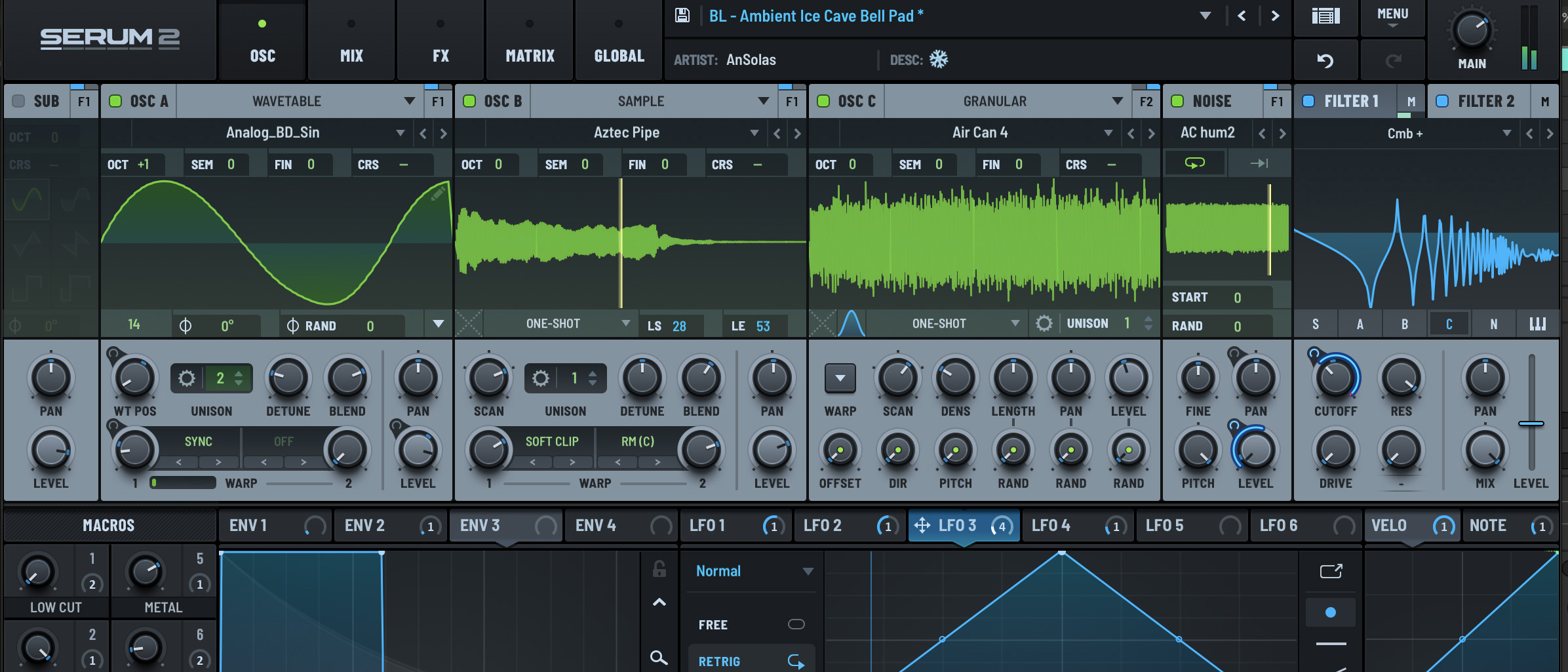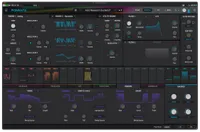MusicRadar Verdict
A modern classic refreshed and rearmed.A hugely powerful sound engine combined with lifetime free updates makes Serum a genuine must-have for electronic music makers.
Pros
- +
New oscillator modes and filters vastly expand the synth's potential.
- +
Refreshed modulation and effects setups are very user-friendly.
- +
Lifetime free updates for owners of any version of Serum.
Cons
- -
Some interface elements can feel a little cramped.
MusicRadar's got your back
Released a little over 10 years ago, the original Serum was an all-singing, all-dancing wavetable synth designed to balance depth and inspiration. Serum was pitched as a ‘dream synthesizer’, born in the mind of DJ, Deadmau5 collaborator and founder of Xfer Records Steve Duda.
While Serum’s creation was something of a passion project, its appeal was universal. The plugin quickly became a favourite of electronic producers of all stripes, inheriting Massive’s softsynth crown to become the go-to tool that every producer should have on their hard drive.
What is it?
Serum’s design featured numerous highlights – in fact, the sheer volume and comprehensiveness of the tools it offered was one of its biggest selling points – but there were a few key design choices that made it stand out from the soft synth crowd.
For one thing, the wavetable oscillators employed impressive anti-alliasing tech and were noticeably cleaner and brighter than those of many rivals. They also made use of a deep and powerful wavetable editor, which allowed users to draw or import custom waveshapes.
Serum took a particularly user-friendly approach to its varied modulation tools too, allowing users to click and drag elements to quickly route a source to a destination.
Now with Serum 2, released as a free update for existing owners, Serum is building on these ideas, adding a host of new features that both expand on the concepts of the original, and bring the synth in line with competitors that have built on those ideas in the decade since its release.
Pricing
- $249 including lifetime free updates. Rent-to-own available priced at $9.99 per-month.
Performance
The most significant changes for Serum 2 come to the oscillator section. Whereas v1 featured two main wavetable oscillators, Serum now has three oscillator modules that can each make use of five different oscillator modes.
Want all the hottest music and gear news, reviews, deals, features and more, direct to your inbox? Sign up here.
Alongside wavetable functionality, the oscillators can now function in sample, multisample, granular and spectral modes, each of which manipulates and plays back source audio in a different manner.
The basic functionality of these should be broadly familiar to most synthesists, although fittingly each offers plenty of flexibility and some interesting creative tools. The sample, granular and spectral modes, for example, have a nice level of flexibility over sample start/end positions, looping options and the ability to slice samples either automatically or manually.
The warp functionality, added to Serum’s wavetable oscillators a few years ago, has been significantly expanded in this latest version. These warp modes affect the way the oscillator plays back the sampled audio and can alter the tonality significantly.
The list of warp modes, available for all oscillator types, has been expanded for version 2 and now encompasses a wide variety of effects ranging from filtering of the waveform to audio-rate modulation, distortion and wavefolding. Serum 2 allows for two of these warp types to be applied simultaneously to each oscillator, with level controls dictating the depth of each effect.
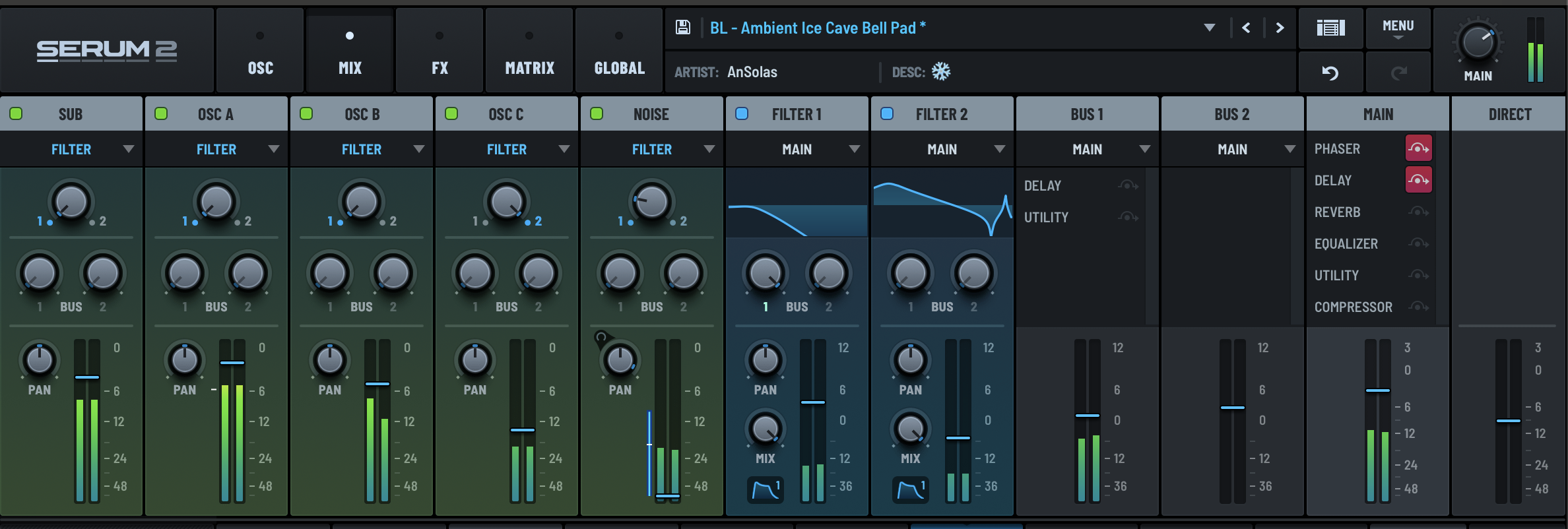
These warp effects bear a resemblance to the playback modes on offer in Native Instruments’ underrated Massive X, although Serum’s list of options is more expansive. This is one of several fronts where it feels like Serum 2’s feature updates are specifically targeted at pulling it in line with some of its contemporaries.
The interchangeable oscillators themselves feel designed to roughly compete with the capabilities of Arturia Pigments, which uses similarly interchangeable oscillator engines capable of wavetable, sample-based and additive synthesis (the latter achievable in Serum via its waveform editor).
Similarly Pigments-like is Serum’s newly upgraded filter section. This makes use of a new dual filter design, with two individual filter slots that can be filled with a multitude of types from Serum’s list of filter models. This list was already thoroughly extensive with v1, but grows here to incorporate new options including an additional comb filter variation, DJ-style filter and several models based on vintage synth designs.
The path taken by each oscillator and filter can be adjusted in Serum 2’s new mixer section. Here each of the main oscillators, along with the sub oscillator and noise generator, gets its own mini channel strip, as do both filters. This allows for control over the routing of each element along with level and pan position.
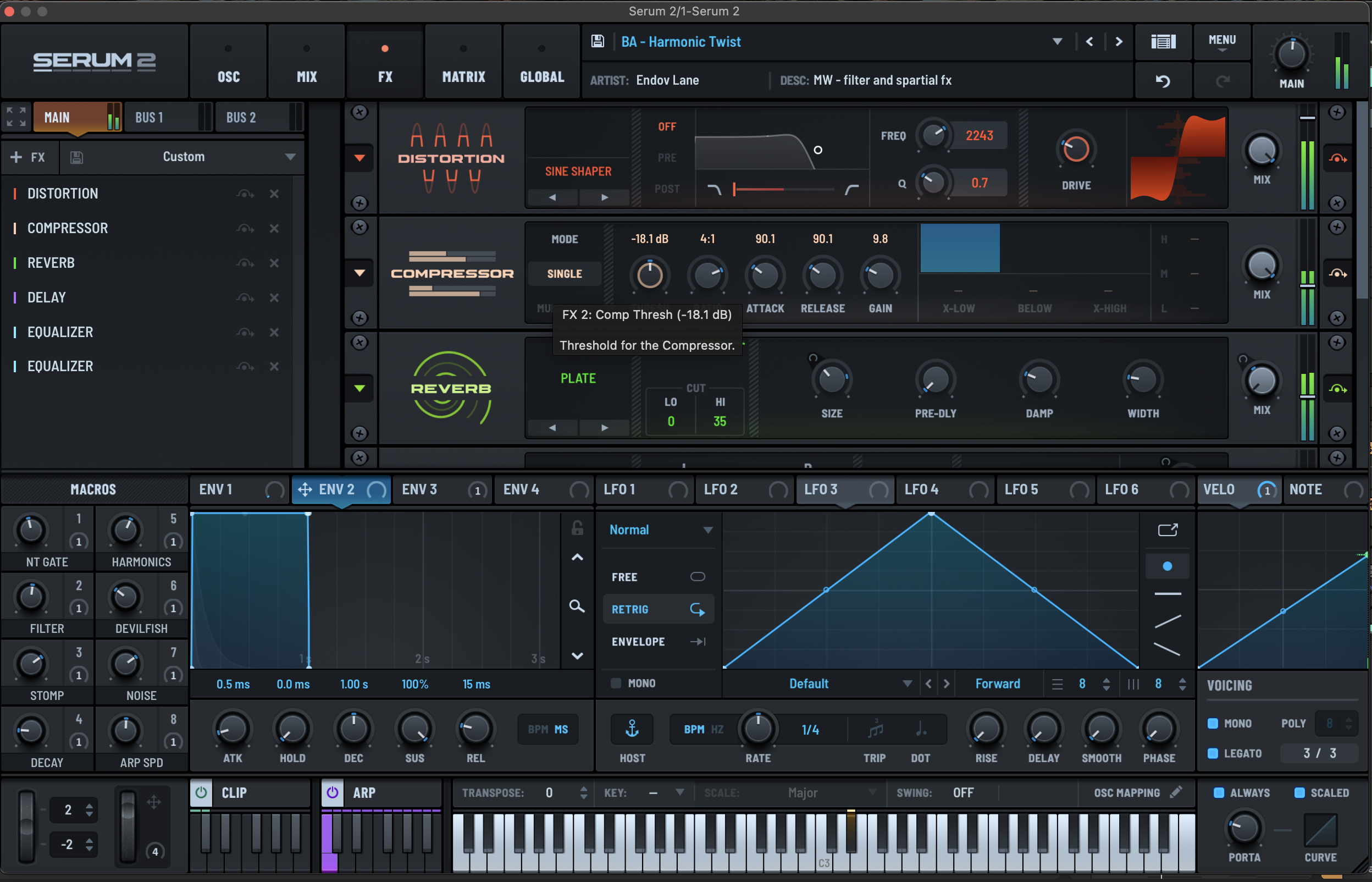
Serum 2 also has two effect busses, which can be used alongside a master effect chain. These are configured using the synth’s newly refreshed effects window.
As with the rest of Serum, this benefits from a slightly tarted-up UI along with a handful of fresh tools. These include several new effects modules, a convolution reverb, frequency shifter, expanded reverb and delay functionality, and more.
The most useful additions on the effect front, however, are the new utility and splitter modules. Utility offers basic low- and high-pass filters as well as control over the width and pan of the sound. Its most useful feature is a mono bass mode, with a cutoff control to adjust the cutoff frequency, allowing the user to reign in stereo effects in the lower frequencies.
The splitter modules, meanwhile, can be used to split a signal into different bands by frequency or split out the mid and side signals.
It’s worth noting that, as before, Serum instals alongside an additional Serum FX plugin, which allows the full effect setup to be used in your DAW independently of the synth engine, which adds considerably to the value of the plugin.
All mod cons
The ease and flexibility of modulation has always been one of the highlights of Serum’s workflow. Fundamentally, nothing has been radically overhauled for version 2 on this front, but there are smart refinements across the board.
Many of the modulation sources have been enhanced, both in terms of available numbers and capabilities. Serum can now load up to four envelope generators and 10 LFOs, while the number of assignable macros has doubled from four to eight. New drawing tools add extra flexibility to the already versatile LFOs too.
Serum 2’s best modulation tool, however, is its neat and intuitive modulation matrix. While modulation routings can still be set up using the drag and drop method from the main UI view, opening the full matrix makes it easy to fine tune and keep track of everything that’s going on within a patch. It also makes it far easier to unpick the workings of any preset.
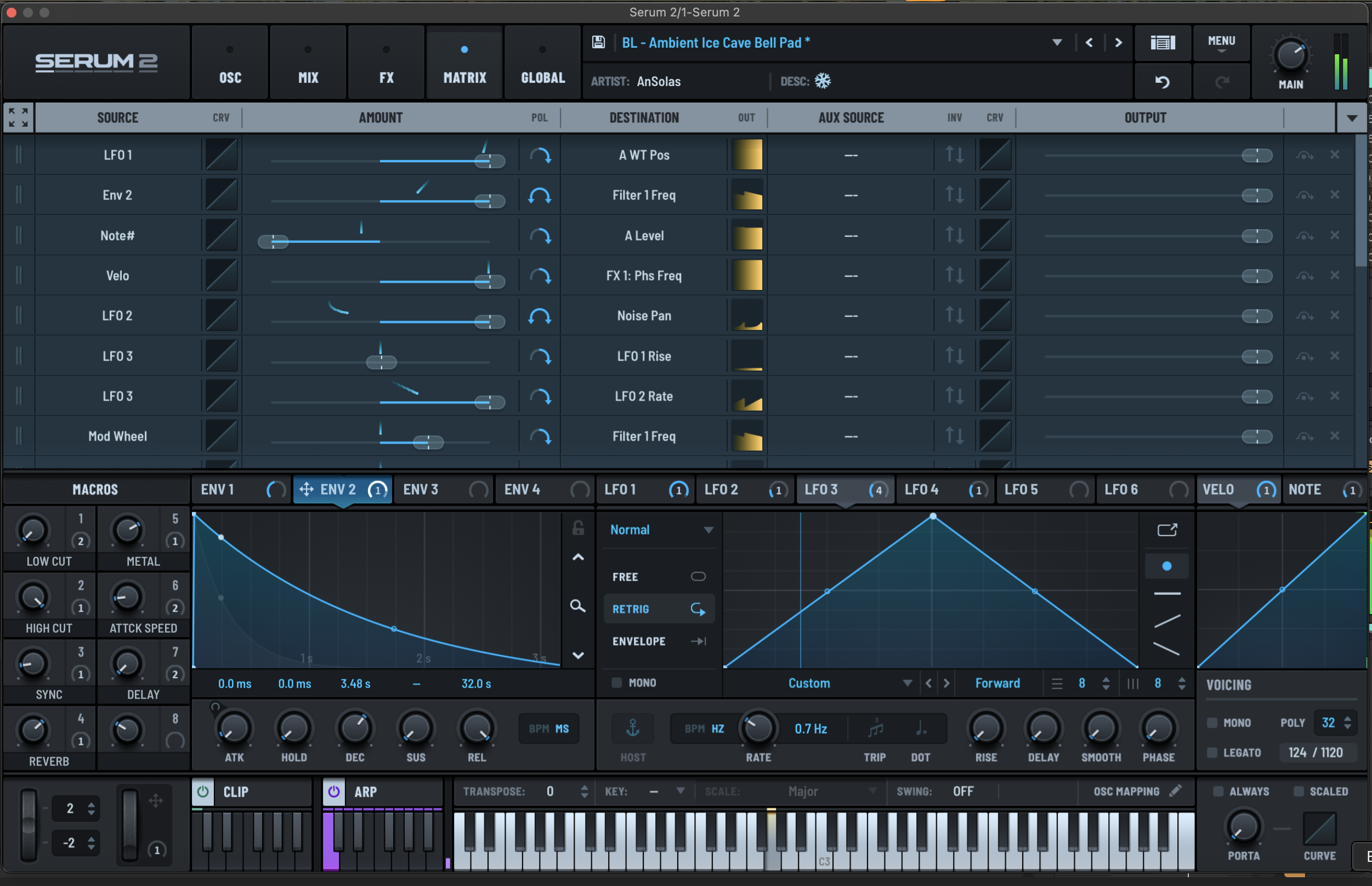
There’s a good level of flexibility to the matrix too, which lets users define an auxiliary source to alter the depth of any modulation – such as using the mod wheel to increase the depth of an LFO, for example – with control over the curve applied to the auxiliary source. Serum 2 allows for its filters and oscillators to be routed as mod sources too, which can lead to some fantastic extreme sound-mangling possibilities.
Beyond the most significant upgrades to Serum’s engine, there are smaller improvements across the board. The UI itself is sleeker and easier to navigate, and the preset browser has been refined too. On that front, Serum 2 also comes equipped with a clutch of new presets, which do a good job of showing off what the synth is capable of whilst also offering plenty of sounds that are usable and inspiring day-to-day.
The synth’s onboard sequencer and arpeggiator have been upgraded too. In all honesty, these are areas I rarely touch in softsynths – generally leaning on tools in a DAW or MIDI controller instead – although Serum 2’s flexible new system of chainable clips makes a solid case for keeping your sequencing and automation in-house.
Return of the king?
Back in the late ‘10s, Serum felt like it was the one plugin that every electronic music maker had to own – a go-to synth that cropped up on the hard drive of any producer worth their salt. In recent years, that crown has slipped a little as other instruments have caught up on Serum’s capabilities.
We’re reaching a point now where the top-end of synth plugins, including the likes of Serum, Pigments and Phase Plant, can do so much that it can be tough to define one against the other. Each offers multiple ways to generate sound, extensive effects, and at least some form of semi-modular routing capabilities. As such, if you own one do-it-all synth plugin, it’s arguable that there’s little need to buy and learn another.
Even in this content though, Serum still has its own undeniable personality. This lies in the depth and precision of its sample shaping tools. While it remains an instrument that’s easy to get started with, once you delve into its advanced capabilities, Serum is a wonderfully flexible sound design playground, and that’s improved exponentially by the new range of oscillator modes.
Verdict
It's hard to find much in the way of faults with Serum at this point. In UI terms, I'd like a few more options to hide or resize the various interface elements – the effects rack in particular can feel a little cramped. Compared to some of its closest rivals, you could highlight the lack of proper virtual analogue oscillators, although the wavetables cover these sounds well anyway.
It’s particularly laudable too that Serum 2 remains a free upgrade, even a decade on from the launch of the original. As such, the question of whether to buy the synth is a moot point for many – in all likelihood, a lot of our readers will already own Serum, and if you haven’t already you should take this as encouragement to update and re-explore its capabilities.
For newer producers that may have missed the boat the first time around, Serum 2 – while not entirely peerless – still makes a solid case for being the one instrument plugin you need above all others. Particularly seeing as it's available at affordable rent-to-own rates, a copy of Serum might be the smartest investment any budding producer makes.
Alternatives
Arturia's Pigments is probably Serum's closest rival currently, offering a similar mix and match approach to sound creation along with annual updates that have (so far) been free to all users.
Specifications
Key features | Serum comes with over 626 presets, 288 wavetables. |
Requirements | PC/Mac Available as VST3, AU, AAX 64bit. |
Contact |
I'm the Managing Editor of Music Technology at MusicRadar and former Editor-in-Chief of Future Music, Computer Music and Electronic Musician. I've been messing around with music tech in various forms for over two decades. I've also spent the last 10 years forgetting how to play guitar. Find me in the chillout room at raves complaining that it's past my bedtime.
You must confirm your public display name before commenting
Please logout and then login again, you will then be prompted to enter your display name.
